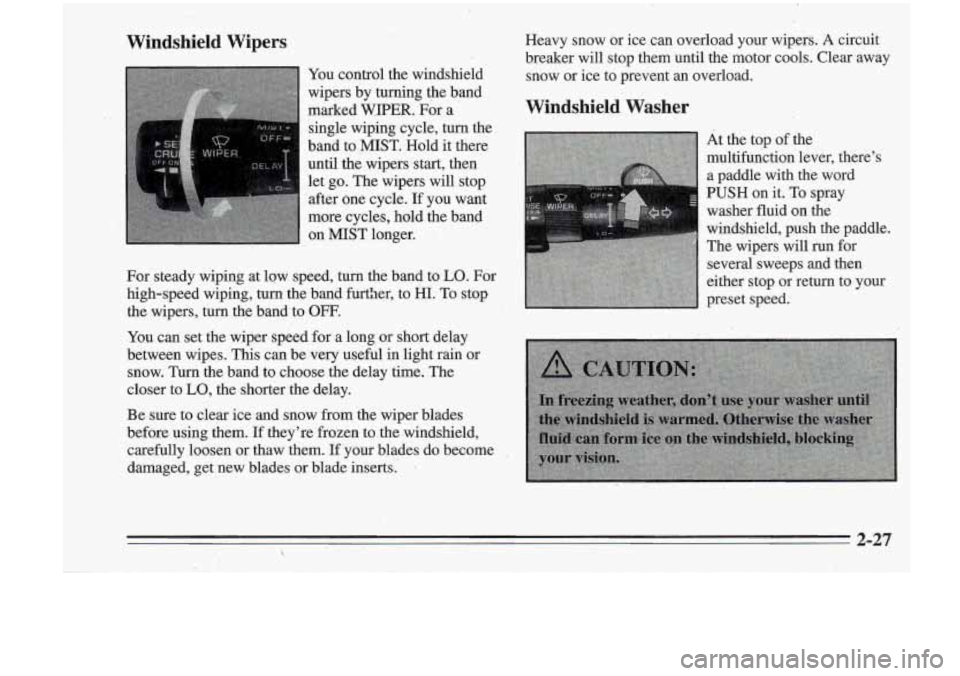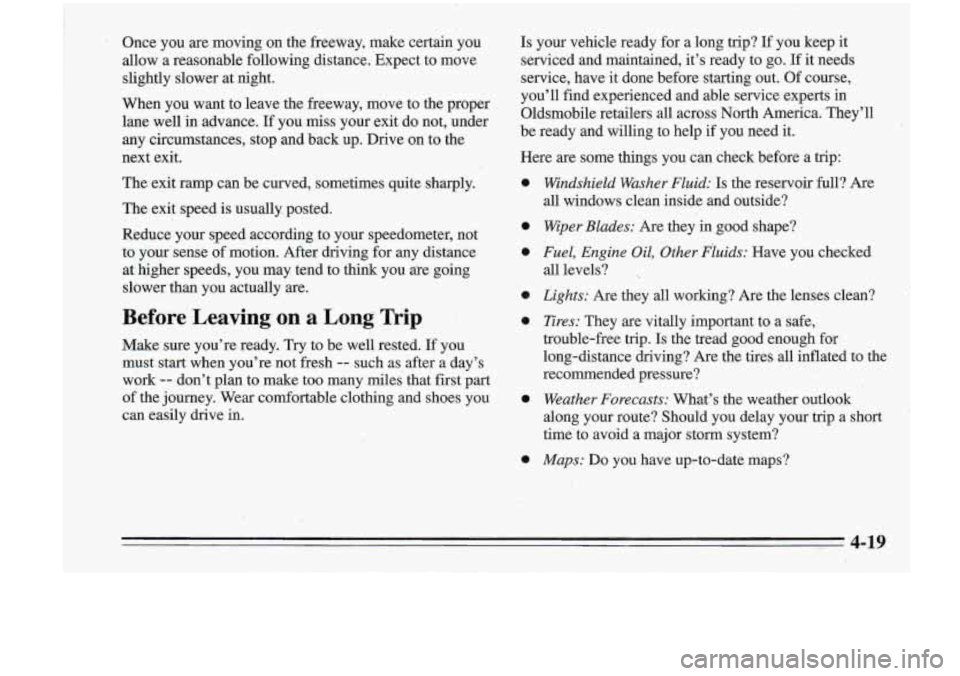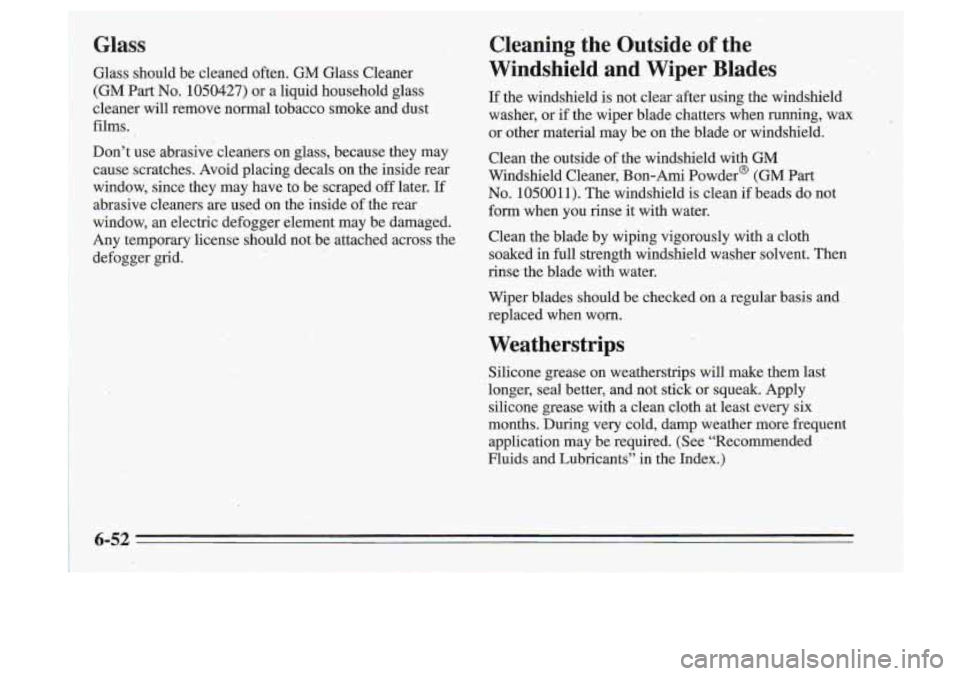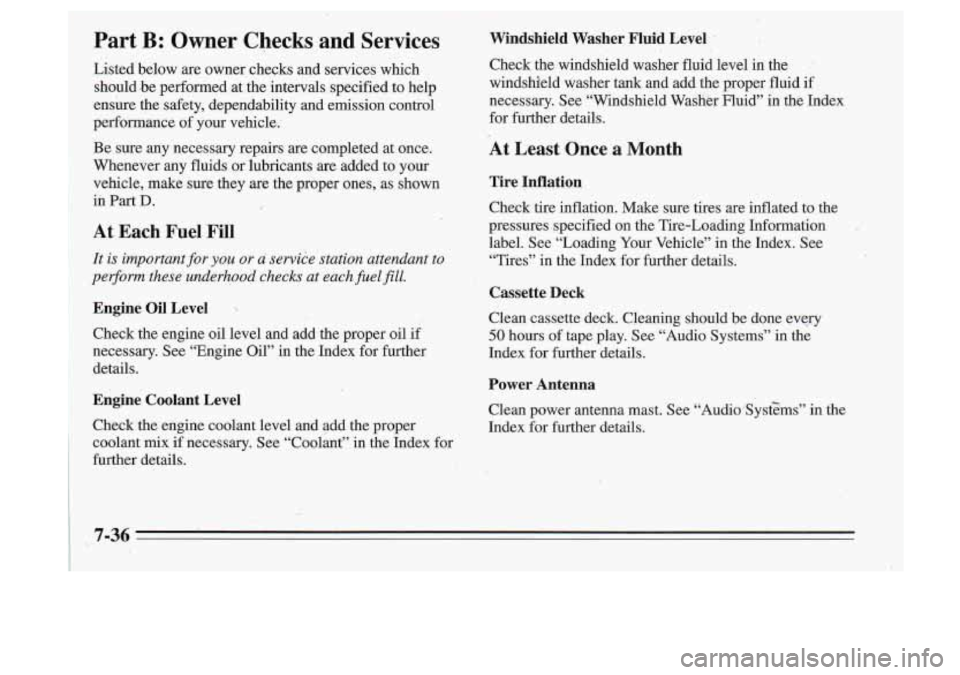Page 85 of 340

Windshield Wipers
You control the windshield
wipers by turning the band
marked
WIPER. For a
singl’e wipi.ng cycle, turn the
band
to MIST. Hold it there
until the wipers,&ut, then
let go. The wipers will stop
after one cycle.
If you want
more cycles, hold the band
on MIST longer.
~
For steady wiping at low speed, turn the band to LO. For
high-speed wiping,
turn the band furtber, to HI. To stop
the wipers,
turn the band to OFF.
You can set the wiper speed for a long or short delay
between wipes. This can be very useful in light rain or
snow. Turn the band to choose the delay time. The
closer to.
LO, the shorter the delay.
Be sure to clear ice and snow from the wiper blades
before using them.
If they’re frozen to.the.windshield,
carefully loosen or thaw them.
If your blades do become
damaged, get new blades or blade inserts.
~
Heavy snow or ice can overload your wipers. A circuit
breaker will stop them until the motor cools. Clear away
I
snow or ice to prevent an overload.
Windshield Washer
At the top of the
multifunction lever, there’s
a paddle with the word
PUSH on it. To spray
washer fluid on the
windshield, push the paddle.
The wipers will run for
several sweeps and then
either stop or return
to your
preset speed.
2-27
Page 157 of 340

3 Once you are m,oving on the freeway, make certain you
allow a reasonable following distance. Expect to move
slightly slower at night.
When you want to leave the freeway, move to the proper
lane well in advance.
If you-miss your exit do not, under
any circumstances, stop and back up. Drive on to the
next exit.
The exit ramp can be curved, sometimes quite sharply.
The exit speed is usually. posted.
Reduce your speed according to your speedometer, not
to your sense of motion. After driving for any distance
at higher speeds, you may tend to think you are going
slower’than you actually are.
Before Leaving on a Long- Trip
Make sure you’re ready. Try to be well rested. If you
must
start when you’re not fresh -- such as after a day’s
work
.-- don’t plan to make too many miles that first part
of the journey. Wear comfortable clothing and shoes you
can easily drive in. Is your vehicle ready
for a long trip? If you keep it
serviced and maintained, it’s ready to go.
If it needs
service, have it done before starting out. Of course,
you’ll find experienced and able service experts in
Oldsmobile retailers all across North America. They’ll
be ready and willing to help
if you need it.
Here are some things you can check before a trip:
0
0
0
0
0
0
0
,Windshield Washer Fluid: Is the reservoir full? Are
all windows clean inside and outside?
Wiper Blades: Are they in good shape?
Fuel, Engine Oil, Other FZuids: Have you checked
all levels?
,
Lights: Are .they all working? Are the lenses clean?
Tires: They are vitally important to a safe,
trouble-free trip. Is the tread gaod enough for
long-distance driving? Are the tires all inflated to the
recommended pressure?
Weather Forecasts: What’s the weather outlook
along your route? Should you delay your trip a short
time‘to avoid a major
storm system?
Maps: Do you have up-to-date maps?
,
Page 160 of 340
Winter Driving
Here are some tips for winter driving:
Have your Oldsmobile in good shape for winter. Be
You may want to put winter emergency supplies in
sure your
engine coolant
mix is correct.
your
trunk.
Include an ice scraper, a small brush or broom, a supply
of .windshield washer fluid, a rag, some winter outer
clothing, a small shovel,
.a flashlight, a red cloth, and a
couple of reflective warning triangles. And, if you will
be driving under severe conditidns, include a small bag
of sand, a piece of old carpet or a couple of burlap bags
to help provide .traction. Be sure you properly secure
these items in your vehicle.
4-22
Page 213 of 340
With the 3.4L LQ1 (Code X) engine, when you open the hood, you’ll see:
1. Radiator Pressure Cap
2. Engine Coolant Reservoir
3. Power Steering Fluid Reservoir
4. Electric Engine Fans
5. Engine Oil Dipstick
6. Engine Oil Fill Cap
7. Coolant Bleed Valves
8. Automatic Transaxle Fluid Dipstick
9. Brake Fluid Reservoir
10. Air Cleaner
11. Windshield Washer Fluid Reservoir
6-9
Page 228 of 340
Windshield Washer Fluid
What to Use
When you need windshield washer fluid, be sure to read the manufacturer’s instructions before use. If you will be
operating your vehicle in an area where the temperature
protection against freezing.
. .
~ may fall below freezing, w .a fluid $kt has s~$f;Cimt.
To Add
Open [he cap labeled WA,S,HER FLUID ONLY. Add
washer, fluid until the tank is full. 1
NOTICE:
0
0 When using concentrated washer fluid,
follow the manufacturer’s instructions for
adding water.
Don’t mix water with ready-to-use washer
fluid. Water can cause the, solution to freeze
and damage your washer fluid tank and
other parts of the washer system. Also,
water doesn’t clean as well
as washer fluid.
Fill your washer fluid tank only
3/4 full
when it’s very cold. This allows for
expansion, which could damage the tank._if
it
is completely full.
Don’t use radiator antifreeze in your
windshield washer. It can damage your
washer system and paint. ,.
Page 256 of 340

Glass
Glass should be cleaned often. GM Glass Cleaner
(GM Part No. 1050427) or a liquid household glass
cleaner will remove normal tobacco smoke and dust
films.
Don’t use abrasive’ cleaners on glass, because they may
cause scratches. Avoid placing decals
on the inside rear
window, since they may have to be scraped
off later. If
abrasive cleaners are used on the inside of the rear
window, an electric defogger element may be damaged.
Any temporary license should not.~be attached across the
defogger grid.
Cleaning the Outside of the
Windshield and Wiper Blades
If the windshield is not clear after using the windshield
washer, or if the wiper blade chatters when running, wax
or other material may be on ’the blade or windshield.
Clean the outside of the windshield with
GM
Windshield Cleaner, Bon-Ami Powder@ (GM Part
No. 10500 11). The windshield is clean if beads do not
form when you rinse it with water.
Clean the blade by wiping vigorously with a cloth soaked in full strength winqshield washer solvent. Then
rinse the blade with water.
Wiper blades should be checked
on a regular basis and
replaced when worn..
Weatherstrips
..
Silicone grease on ,weatherstrips will make them last
longer, seal better, and not stick or squeak. Apply
silicone grease with a clean cloth at least every six
months. During very cold, damp weather
more frequent
application may be required. (See “Recommended
Fluids and Lubricants” in the Index.)
Page 306 of 340

~ Part B: Owner Checks and Services Windshield Washer Fluid Level
Listed below are owner checks and services which
Check the windshield washer fluid level in the
should
be performed at the intervals specified to help windshield washer tank and add the proper fluid if
ensure the safety, dependability and emission control
necessary.
See “Windshield Washer Fluid” in the Index
performance of your vehicle. for further details.
Be sure any necessary repairs are completed at once.
Whenever any fluids or lubricants are added to your vehicle, make sure they are the proper ones, as shown
in Part
D.
’ At Each Fuel Fill
It is important for you or a service station attendant to
perform these underhood checks at each fuel
fill.
Engine Oil Level
Check the engine oil level and add the proper oil if
1 necessary. See “Engine Oil” in the Index for further
details.
Engine Coolant Level
Check the engine coolant level and add the proper coolant mix
if necessary. See “Coolant” in the Index for
further details.
At Least Once a Month
Tire Inflation
Check tire inflation. Make sure tires are inflated to the
pressures specified on the Tire-Loading Information
label.
See “Loading Your Vehicle” in the Index. See
“Tires” in the Index for further details.
Cassette Deck
Clean cassette deck. Gleaning should,be done every
50 hours of tape play. See “Audio Systems” in the
Index for further details.
Power Antenna
Clean power antenna mast. See “Audio*Syst$ms” in the
Index for further details.
Page 312 of 340
USAGE
Chassis
Lubrication
Windshield
Washer Solvent
Hood Latch
Assembly a. Pivots. and Spring
Anchor
b. Release Pawl
FLUIDLUBRICANT
Chassis lubricant (GM Part
No. 1052497 or equivalent) or
lubricant meeting requirements of
NLGI Grade
2, Category LB or
GC-LB.
GM Optikleen@ Washer Solvent (GM Part No. 1051515) or equiva-
lent.
a. Engine oil.
b. Chassis lubricant (GM Part
No. 1052497 or equivalent) or
lubricant meeting requirements of NLGI Grade 2, Category LB’
or GC-LB.
I USAGE I FLUIDLUBRICANT
Hood and Door Engine oil
or Lubriplate Lubricant
Hinges
I (GM Part No. 1050109).
Fuel Door Hinge Engine oil or Lubriplate Lubricant
Weatherstrip Dielectric Silicone Grease (GM
~ (GM Part No. 1050109). ~~~
I Conditioning ~ I Part No. 12345579 or equivalent). I
See “Replacement Parts” in the Index for recommended
replacement filters, valves and spark plugs.
7-42
-,